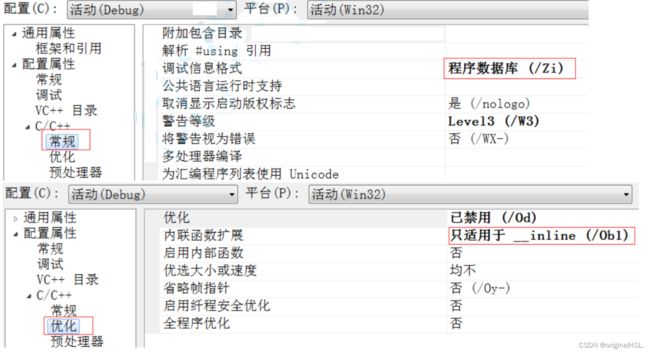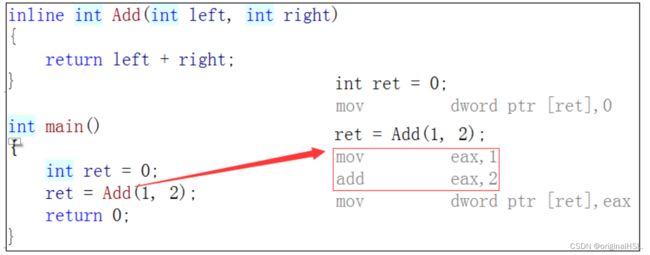C++快速入门 - 2(几分钟让你快速入门C++)
C++快速入门 - 2
- 1. 内联函数
-
- 1.1 概念
- 1.2 特性
- 2. auto关键字(C++11)
-
- 2.1 类型别名思考
- 2.2 auto简介
- 2.3 auto的使用细则
- 2.4 auto不能推导的场景
- 3. 基于范围的for循环(C++11)
-
- 3.1 范围for的语法
- 3.2 范围for的使用条件
1. 内联函数
1.1 概念
以inline修饰的函数叫做内联函数,编译时C++编译器会在调用内联函数的地方展开,没有函数调用建立栈帧的开销,内联函数提升程序运行的效率。

如果在上述函数前增加inline关键字将其改成内联函数,在编译期间编译器会用函数体替换函数的调用。
查看方式:
- 在release模式下,查看编译器生成的汇编代码中是否存在call Add
- 在debug模式下,需要对编译器进行设置,否则不会展开(因为debug模式下,编译器默认不会对代码进行优化,以下给出vs2013的设置方式


1.2 特性
- inline是一种以空间换时间的做法,如果编译器将函数当成内联函数处理,在编译阶段,会用函数体替换函数调用,缺陷:可能会使目标文件变大,优势:少了调用开销,提高程序运行效率。
- inline对于编译器而言只是一个建议,不同编译器关于inline实现机制可能不同,一般建议:将函数规模较小(即函数不是很长,具体没有准确的说法,取决于编译器内部实现)、不是递归、且频繁调用的函数采用inline修饰,否则编译器会忽略inline特性。下图为《C++prime》第五版关于inline的建议:
- inline不建议声明和定义分离,分离会导致链接错误。因为inline被展开,就没有函数地址了,链接就会找不到。
// F.h
#include 【面试题】
宏的优缺点?
优点:
- 1.增强代码的复用性。
- 2.提高性能。
缺点:
- 1.不方便调试宏。(因为预编译阶段进行了替换)
- 2.导致代码可读性差,可维护性差,容易误用。
- 3.没有类型安全的检查 。
C++有哪些技术替代宏?
-
- 常量定义 换用const enum
-
- 短小函数定义 换用内联函数
2. auto关键字(C++11)
2.1 类型别名思考
随着程序越来越复杂,程序中用到的类型也越来越复杂,经常体现在:
- 类型难于拼写
- 含义不明确导致容易出错
#include std::map
#include 使用typedef给类型取别名确实可以简化代码,但是typedef有会遇到新的难题:
typedef char* pstring;
int main()
{
const pstring p1; // 编译成功还是失败?
const pstring* p2; // 编译成功还是失败?
return 0;
}
在编程时,常常需要把表达式的值赋值给变量,这就要求在声明变量的时候清楚地知道表达式的类型。然而有时候要做到这点并非那么容易,因此C++11给auto赋予了新的含义。
2.2 auto简介
在早期C/C++中auto的含义是:使用auto修饰的变量,是具有自动存储器的局部变量,但遗憾的是一直没有人去使用它,大家可思考下为什么?
C++11中,标准委员会赋予了auto全新的含义即:auto不再是一个存储类型指示符,而是作为一个新的类型指示符来指示编译器,auto声明的变量必须由编译器在编译时期推导而得。
int TestAuto()
{
return 10;
}
int main()
{
int a = 10;
auto b = a;
auto c = 'a';
auto d = TestAuto();
cout << typeid(b).name() << endl;
cout << typeid(c).name() << endl;
cout << typeid(d).name() << endl;
//auto e; 无法通过编译,使用auto定义变量时必须对其进行初始化
return 0;
}
【注意】
使用auto定义变量时必须对其进行初始化,在编译阶段编译器需要根据初始化表达式来推导auto的实际类型。因此auto并非是一种“类型”的声明,而是一个类型声明时的“占位符”,编译器在编译期会将auto替换为变量实际的类型。
2.3 auto的使用细则
- auto与指针和引用结合起来使用
用auto声明指针类型时,用auto和auto*没有任何区别,但用auto声明引用类型时则必须加&
int main()
{
int x = 10;
auto a = &x;
auto* b = &x;
auto& c = x;
cout << typeid(a).name() << endl;
cout << typeid(b).name() << endl;
cout << typeid(c).name() << endl;
*a = 20;
*b = 30;
c = 40;
return 0;
}
- 在同一行定义多个变量
当在同一行声明多个变量时,这些变量必须是相同的类型,否则编译器将会报错,因为编译器实际只对第一个类型进行推导,然后用推导出来的类型定义其他变量。
void TestAuto()
{
auto a = 1, b = 2;
auto c = 3, d = 4.0; // 该行代码会编译失败,因为c和d的初始化表达式类型不同
}
2.4 auto不能推导的场景
1. auto不能作为函数的参数
// 此处代码编译失败,auto不能作为形参类型,因为编译器无法对a的实际类型进行推导
void TestAuto(auto a)
{}
2. auto不能直接用来声明数组
void TestAuto()
{
int a[] = {1,2,3};
auto b[] = {4,5,6};
}
3. 为了避免与C++98中的auto发生混淆,C++11只保留了auto作为类型指示符的用法
4. auto在实际中最常见的优势用法就是跟以后会讲到的C++11提供的新式for循环,还有lambda表达式等进行配合使用。
3. 基于范围的for循环(C++11)
3.1 范围for的语法
在C++98中如果要遍历一个数组,可以按照以下方式进行:
void TestFor()
{
int array[] = { 1, 2, 3, 4, 5 };
for (int i = 0; i < sizeof(array) / sizeof(array[0]); ++i)
array[i] *= 2;
for (int* p = array; p < array + sizeof(array)/ sizeof(array[0]); ++p)
cout << *p << endl;
}
对于一个有范围的集合而言,由程序员来说明循环的范围是多余的,有时候还会容易犯错误。因此C++11中引入了基于范围的for循环。for循环后的括号由冒号“ :”分为两部分:第一部分是范围内用于迭代的变量,第二部分则表示被迭代的范围。
void TestFor()
{
int array[] = { 1, 2, 3, 4, 5 };
for(auto& e : array)
e *= 2;
for(auto e : array)
cout << e << " ";
return 0;
}
注意:与普通循环类似,可以用continue来结束本次循环,也可以用break来跳出整个循环。
3.2 范围for的使用条件
for循环迭代的范围必须是确定的
对于数组而言,就是数组中第一个元素和最后一个元素的范围;对于类而言,应该提供begin和end的方法,begin和end就是for循环迭代的范围。
注意:以下代码就有问题,因为for的范围不确定
- C++中的数组无法直接通过传递指针来确定其大小。在函数参数中使用 int array[] 实际上是将其转换为指针类型 int* array。因此,无法在函数内部确定数组的大小。
void TestFor(int array[])
{
for(auto& e : array)
cout<< e <<endl;
}
(本章完)
